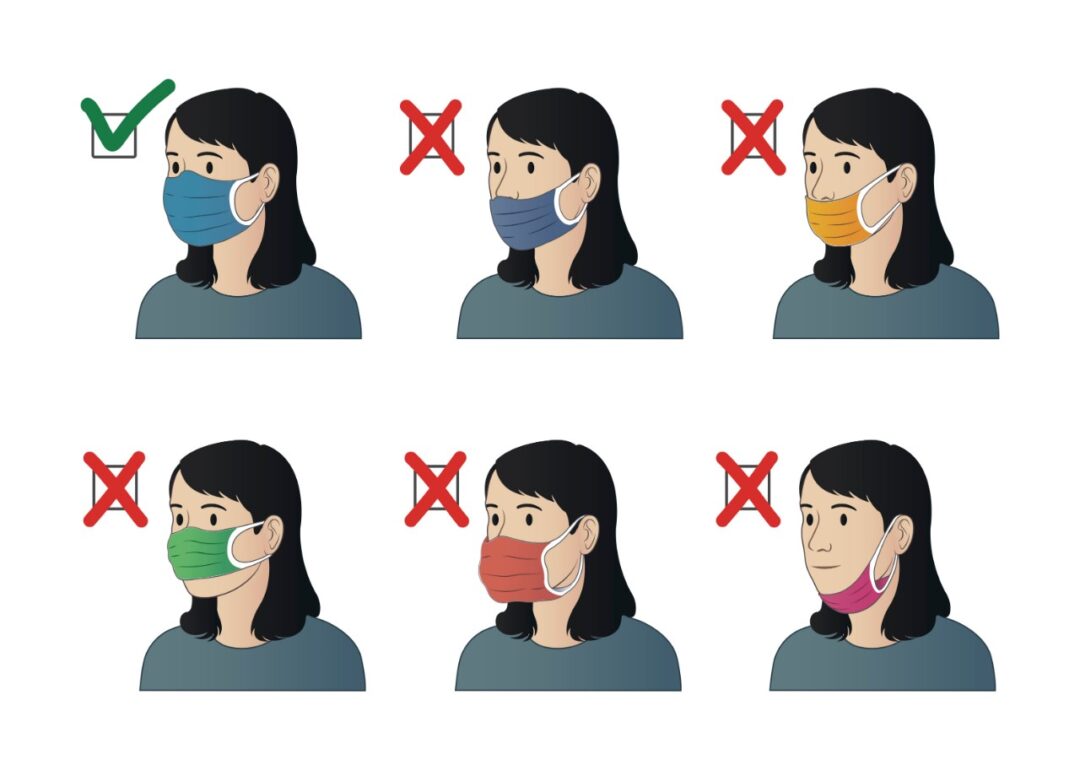How should I wear a face mask? |

As some states start lifting restrictions and reopening businesses, it may seem like the threat from COVID-19 is past us. Unfortunately, that is far from true. The latest models predict significant increases in cases over the next couple of months. We all need to continue to do what we can to help control the spread of the coronavirus. Wearing a face mask, or covering, is one thing that we can all do. Let’s talk about how it works and why it is important.
Why is it important to wear a face covering?
The coronavirus that is responsible for the current pandemic is more contagious than influenza, and even more contagious than other coronaviruses that we have encountered in the past. It spreads through respiratory droplets, or aerosolized particles, that we spread through a cough or sneeze.
An estimated 25% of people with this coronavirus feel perfectly fine and don’t know they are infected, or that they are contagious. It appears that these asymptomatic carriers are responsible for a significant amount of the spread of this virus. You could very well be one of them and not know it!
How can wearing a face covering protect you and those around you?
A simple mask is very effective at trapping droplets from your coughs and sneezes. Studies have been done on patients infected with a variety of viral respiratory infections (such as influenza, cold viruses, and milder coronaviruses), which show that wearing a mask blocks most virus-laden respiratory droplets exhaled. In these studies, with normal un-masked exhaling, infected patients were releasing virus particles into the air 30% of the time, even without a sneeze or cough. Other studies have shown that a cough or sneeze can send those particles at least 6 feet away.
If you wear a mask, you are protecting those around you from being exposed to viral droplets that you might exhale even with normal breathing, and especially with a cough or sneeze.
We all have a responsibility to do what we can to decrease the spread of this infection, and wearing a mask is a great way to protect those around you from getting exposed. Remember, you may not even know you are spreading it! In fact, I think you are being disrespectful to those around you if you are going into public buildings, or coming within 6 feet of others, without wearing a mask.
How well a mask protects the wearer depends on the quality of the material used, and the fit of the mask. If you are practicing social distancing, and washing your hands often, and you wear a mask made out of 2 layers of a heavy cotton or flannel, that fits properly, you are lowering your risk of getting sick.
Dos and Don’ts of Wearing a Face Covering
How to put on, wear, and take off a mask
- Always wash your hands firsts
- Don’t touch the fabric part of the mask (that is where the germs are getting trapped and you don’t want that on your hands)
- Use the ear loops or ties to secure your mask and to remove it.
- The mask should cover the area from near the bridge of your nose to down below your chin, and should reach on the sides to about halfway or more toward your ears.
- Pull the ties or loops so that it fits as snugly as possible against your face.
- If there is a metal nose piece, you can bend this to fit your nose.
- If your mask has pleats, the folded part of the pleat should be down.
How NOT to wear your mask
- Don’t take one loop off your ear to talk.
- Don’t tug the mask down so that your nostrils are uncovered.
- Don’t wear the mask with the bottom edge above your chin.
Should you wear a mask outdoors?
If you are going to be within 6 feet of others, you should wear a mask, even outdoors.
Should you wear a mask at home?
You only need to wear a mask at home if someone is sick. In this case, the person who is sick should be confined to a separate room with minimal to no contact with others in the household (including pets) and should use a separate bathroom if possible. Both the person who is sick and the caregiver should wear a mask when in contact with each other. The caregiver should wash their hands as soon as they remove their mask after leaving the room.
How can you make your own mask?
- There are a variety of mask patterns that are available online. If you have basic sewing skills, a mask is an easy sewing project. There are also no-sew mask patterns available as well. I will provide links below.
- A variety of fabrics can be used to make a mask, including cotton quilting fabric, an old T shirt, a tightly woven tea towel (not terry cloth), flannel (from an old shirt or pajamas), and bandanas. You should hold the fabric up to the light to see how much light comes through; the less light comes through, the tighter the weave and the better protection it will provide.
- Ideally your mask should have 2 fabric layers, preferably with one edge open so that you can put a paper towel or coffee filter between the layers for added protection. The coffee filter or paper towel can be thrown away before washing and replaced with a new one prior to the next use.
How do you take care of a mask?
- If you have a surgical mask or N95 mask, you can’t really clean those. They just need to be replaced with a new one.
- A fabric mask should be washed regularly with soap and water. Bleach seems tempting, but bleach or hydrogen peroxide can degrade the fabric fibers, which will make the mask less effective. Soap and water works great to kill viruses. You can air dry it or put it in the dryer.
- Do NOT put your face covering in the microwave. This does not sanitize it adequately, and it is a fire hazard. Most cloth material will catch fire if in the microwave for very long. Surgical masks also contain a metal nose piece, which is certainly not microwave-friendly.
- It is not necessary, but if you want you can run a hot iron over the mask before wearing, if it makes you feel like you’ve made a full assault on any germs that might remain after washing.
Let’s all try to do our part to stop the spread of coronavirus. If you have any questions about masks, or other questions about coronavirus, please send a question in to one of our doctors.
Here are a couple of links to help you make your own mask:
A simple no-sew mask – https://www.youtube.com/watch?v=tPx1yqvJgf4
Another no-sew mask – https://www.youtube.com/watch?v=KQZPhj_erhg
If you have any more questions just Ask Hanna, our health advisors are here to help.
Dr. Anita Bennett MD – Health Tip Content Editor
Image: ©Shutterstock / Pemimpi








